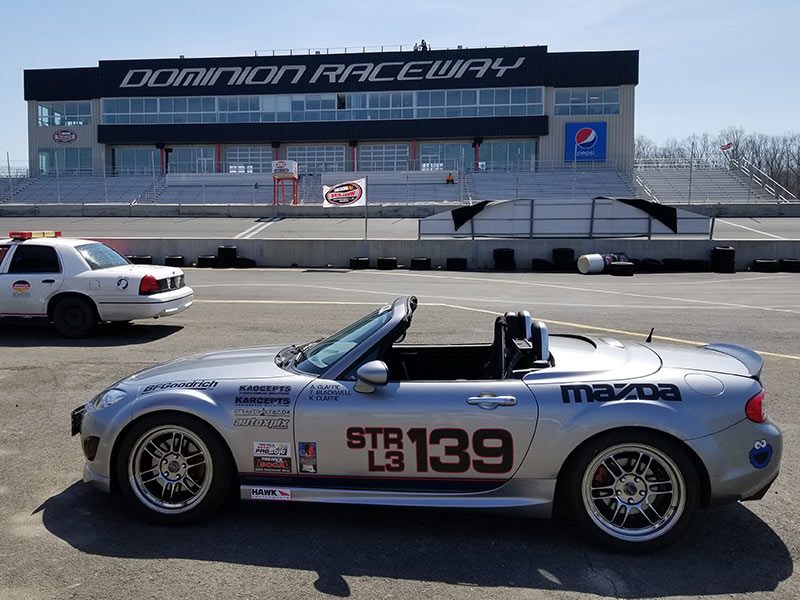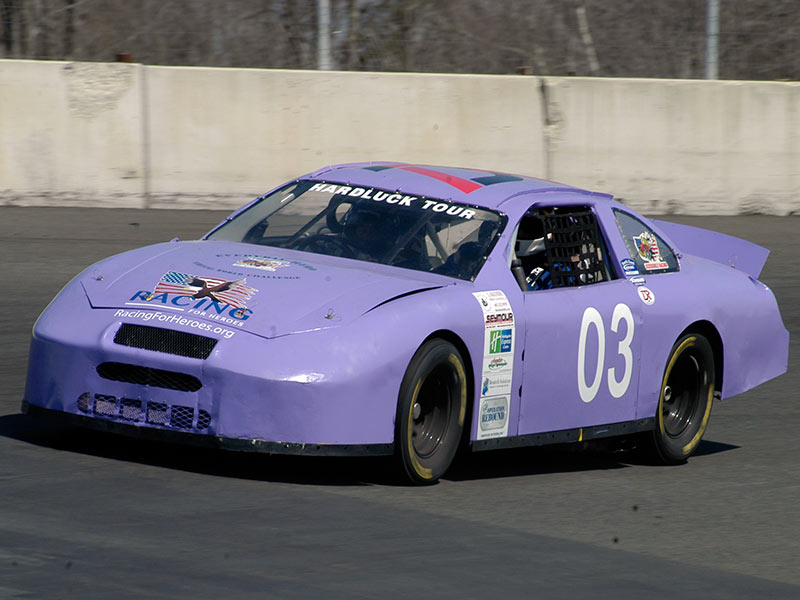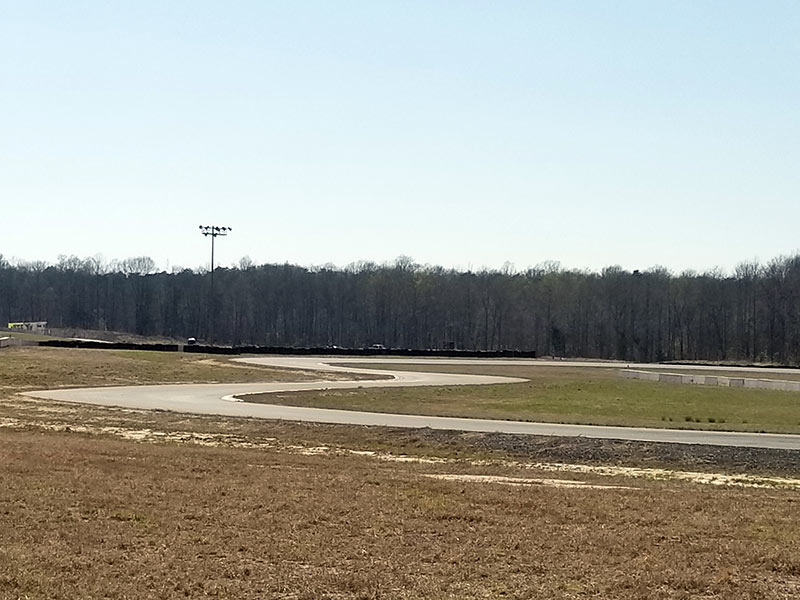We've been semi-serious autocrossers for nearly ten years now. All this time, I've been pretty content to let that be the extent of my #funwithcars, as the Sports Car Club of America says. Others use autocrossing as a gateway drug, going from there to participating in track days and maybe going beyond that to doing actual real racing. But that's not me.
There are a few reasons why I've never done a track day. The first should come as no surprise to those who know me: they're not cheap. A single day on Summit Point's main circuit is $295, which is a season's worth of Capital Driving Club's Waldorf events plus a season's worth of NCCBMWCCA Waldorf autocrosses, and probably with a couple bucks left over. The costs add up in increased wear and tear on the car, including brakes and tires.
 Secondly, I don't really have anything trackable. The fun stuff in the fleet are all convertibles, and none of them have true rollover protection. The NC Miatas have factory roll hoops, but it's unclear whether those are allowed on track. Even if they were, I don't know if they'd be effective in the (unlikely) event that I wind up upside-down. The only other option is the automatic Honda Fit, and there is no appeal to drive that in anything resembling a sporting manner.
Secondly, I don't really have anything trackable. The fun stuff in the fleet are all convertibles, and none of them have true rollover protection. The NC Miatas have factory roll hoops, but it's unclear whether those are allowed on track. Even if they were, I don't know if they'd be effective in the (unlikely) event that I wind up upside-down. The only other option is the automatic Honda Fit, and there is no appeal to drive that in anything resembling a sporting manner.
Finally, I am not sure if I'd actually enjoy being on a track. With a relatively slow car, the straightaways seem really long and the corners way too far away from each other. The risks are real, and having those in the back of my mind would temper my enthusiasm for going really fast.
Having said that, I figured I would like to try it once if the opportunity presented itself. That would probably come in the form of SCCA's Track Night in America, assuming the NC would be allowed to play.
The opportunity presented itself in an unexpected way last week, and I took advantage of that.
Brian Hanaford, who I knew from many years ago when we were both involved in the New England short-track racing scene, showed up on my radar a month or so ago. He had been working on a program that invited wounded military veterans to come to a race track, where they would be given the opportunity to drive a NASCAR stock car. His car has been fitted with an automatic transmission, hand controls, and a removable door and hinged roll cage for easier access. He was going to have this car at Dominion Raceway, a kinda sorta local track. He usually has the legendary "Dynamite" Dave Dion helping out, and I asked about showing up to see both Brian and Dave, and see Accessible Racing in action.
Brian invited me to the track, and hinted that I should bring a fun car as they will be doing things at both the 4/10-mile oval and the two-mile road course.
 I arrived in time to see the veterans about to start their behind-the-wheel experiences, starting with flogging an old police car around a watered-down skidpad. They then moved on to the oval, where they got to drive around Dominion's two-year old track.
I arrived in time to see the veterans about to start their behind-the-wheel experiences, starting with flogging an old police car around a watered-down skidpad. They then moved on to the oval, where they got to drive around Dominion's two-year old track.
After lunch, action shifted to the road course. To familiarize those drivers with the track, they were driven around it in a pair of track cars from Racing For Heroes. As this was going on, Brian said that if I wanted to run the track myself, have at it.
Well, I had just happened to bring a very capable Miata, a helmet, driving gloves and shoes, and a fully-charged GoPro camera. I was suited up and ready to hit the track in a matter of minutes.
I told one of the guys running the program that I was going to behave myself, and that I'd probably not go much more than 80% balls-out. Even though I had meant to see if there were any YouTube videos of the road course that I could use to familiarize myself with its layout, I did not. So the first time I saw the track was when I drove off of pit road.
Fortunately, Dominion is a fairly simple track without any tricky blind corners or elevation changes. After a couple of laps I was pretty sure that I would not be surprised by anything and ratcheted up the speed a couple notches. The runs down the main straight were fun as I glanced down and saw the speedometer touching 110 MPH. I was pretty conservative, braking early going into the first turn and avoiding the curbing in the turns to avoid upsetting the car. The wiggles down the back straightaway were entertaining as long as I didn't try to carry too much speed through them as that seemed to be the only place where I could really get into trouble. I had to take it a little easy going through the last couple corners as there was a bump under the bridge that caused a little tire rub.
 Each time I drove by pit road where the stock car was being readied for road course duty, I looked to see if someone was waving me in. I was aware of the other track cars sharing the track, but they were only on track for a few laps at a time before ducking back into the pits to change passengers. I never caught them and they never caught me.
Each time I drove by pit road where the stock car was being readied for road course duty, I looked to see if someone was waving me in. I was aware of the other track cars sharing the track, but they were only on track for a few laps at a time before ducking back into the pits to change passengers. I never caught them and they never caught me.
As I kept putting laps in, I was very aware of how much I was pushing braking zones. The Miata has Hawk HPS pads, which aren't exactly track pads, so I tried not to lean on them too heavily. But they didn't feel as good as they had when I started, so I figured it would be good to take a break. After twenty minutes on-track, I brought the car to the pits and parked it on pit road.
My first thought upon stopping was, "that was neat." The next thought was, "I don't have to do this again."
Don't get me wrong, it was fun. The only other times I've been on tracks before were during parade laps, where sometimes I was close to the front of the line behind a pace car and kept up. Sometimes I was further back and subject to the limitations of bravery on the part of those in front of me, and that was less fun. Left to my own devices, with no pace car, I felt like I had definitely gone as fast as I'd have liked. The only thing limiting my speed was self-preservation, and that doesn't mean just not falling off the pavement. There was also the thought of needing rescuing after crashing off a track I may not have necessarily been allowed to be on in the first place, and the thought of making the phone call home to have Kate hook the trailer to the truck and come down to Thornburg, Virginia to tow what's left of our car back home.
The novelty of running on a track wore off fairly quickly. Seeing triple-digit speeds was novel, I won't deny that. But driving a two-mile track by myself wasn't really a thrill. There was no timer to let me know if I was getting better with the more laps I ran, and there were no other cars to chase or be chased by.
 There is a SCCA program that adds a time trial to track days, though that adds another hundred bucks to the entry fee. It also introduces a competitive element to track driving, and that means no longer being conservative about braking points and tire use, which means there are increased chances of pushing beyond reasonable limits and falling off the track.
There is a SCCA program that adds a time trial to track days, though that adds another hundred bucks to the entry fee. It also introduces a competitive element to track driving, and that means no longer being conservative about braking points and tire use, which means there are increased chances of pushing beyond reasonable limits and falling off the track.
Maybe I would have enjoyed my track experience better if I were there with a few friends rather than having the place to myself. This could happen at a Track Night in America, though that adds more complications in the form of having to watch my mirrors for faster traffic. It could also introduce peer pressure to go faster than I would otherwise, since now I would be performing in front of an audience.
I certainly appreciate Brian and Accessible Racing for the invitation to come to Dominion Raceway and let me see their program in action. I also appreciate their making the track available to me to try it out for myself. I learned a thing or two doing that, the most important of which is that track days probably aren't for me. I can now return to doing my performance driving in parking lots and airport runways without having to wonder what I'm missing.
